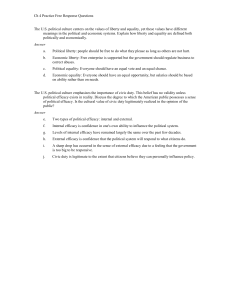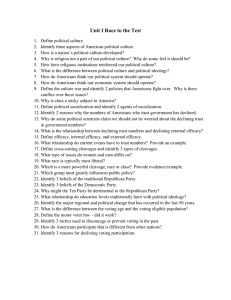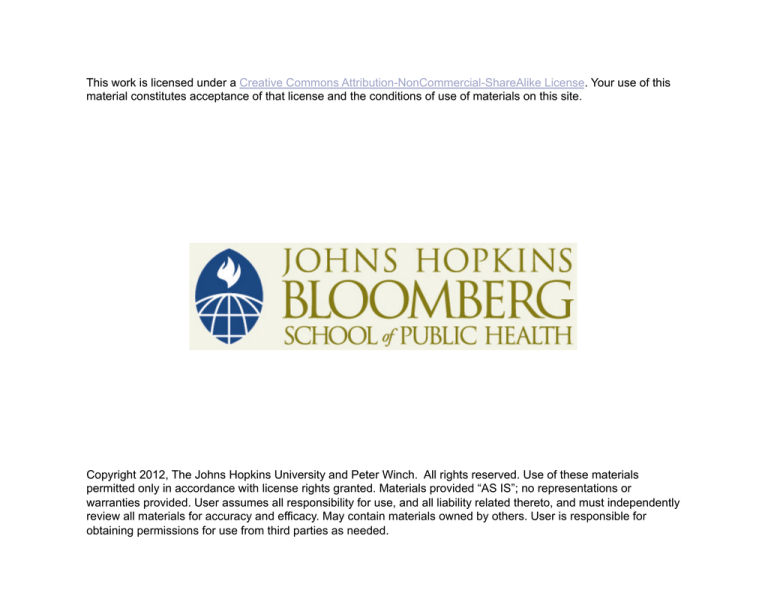
This work is licensed under a Creative Commons Attribution-NonCommercial-ShareAlike License. Your use of this
material constitutes acceptance of that license and the conditions of use of materials on this site.
Copyright 2012, The Johns Hopkins University and Peter Winch. All rights reserved. Use of these materials
permitted only in accordance with license rights granted. Materials provided “AS IS”; no representations or
warranties provided. User assumes all responsibility for use, and all liability related thereto, and must independently
review all materials for accuracy and efficacy. May contain materials owned by others. User is responsible for
obtaining permissions for use from third parties as needed.
Illness etiologies,
levels of causality
Peter Winch
Health Behavior Change at the Individual,
Household and Community Levels,
224.689
Recap
SBI Core course sequence
TERM
Courses
2
224.689 Health Behavior Change
at the Individual, Household &
Community Levels, 4 units
224.690 Qualitative Research
Theory & Methods, 5 units (Lab)
224.691 Qualitative Data Analysis,
5 units (Lab)
224.692 Formative Research for
Behavioral and Community
Interventions, 4 units
3
4
Time
Tues-Thur
8:30-10:20
Tues-Thur
8:30-10:20
Mon-Wed
8:30-10:20
Mon
10:30-12 &
Fri 8:30-12
What’s in a name?
Health Behavior
Change at the
Individual, Household
and Community Levels
CoursePlus website
150 articles posted already
Impossible to read them all
Be selective in your reading
– Past experiences
– Previous disciplinary training
– What interests you
Course evaluation
No midterm exam
No final exam
Grading is based on:
– 25%: Online quizzes in CoursePlus due
the night before each discussion group
– 75%: Written assignments
Written assignments
Assignment
Due date
Percent Pages
Grading
of final (Double- process
grade
spaced)
Response paper
on discussion 1 &
2 or 1st 2 modules
Final assignment:
Q1 plus outline for
Q2 & Q3
Thur 10
Nov
15%
5-6
Tues 06
Dec
10%
5-6
Final assignment:
Revised Q1 + Q2
& Q3
Wed 21
Dec
50%
10
Graded
with form
in syllabus
Graded
with form
in syllabus
Graded
with form
in syllabus
Response paper
Object is to get you thinking and reading,
learn what we are looking for when grading
Not necessary to look up additional articles,
there are more than enough already on
CoursePlus
Go into more detail on a question of interest
that came up during discussion or lecture
Should clearly describe the issue/
concept and a response from your own
perspective
Final assignment: Scenarios
Over-use of antimalarials by health workers
in low-transmission setting
– Tanzania (or other country)
Micronutrient home fortification in
humanitarian relief
– Damak Refugee Camp, Nepal
– Dadaab Refugee Camp, Kenya
Reducing household energy consumption
– USA or other high or middle-income
country
1140 pounds: Total monthly coal consumption for an
average US household resulting in 3369 pounds of carbon
dioxide emissions
Source: http://www.sierraclub.org/sierra/200901/coal.aspx
Who needs to change?
High-income
Unsustainably high
consumption of
– Fossil fuels
– Soil, water, forests
– Animals & fish
Inhumane methods of
animal production
Obesity and chronic
disease
Low-income
Malnutrition
Infectious diseases
Population growth
Low literacy rates
BUT: More sustainable
levels of consumption
Assembling your expertise as a
behavior change specialist
Undergrad &
other training
Professional
associations
Exposure to
other cultures
and languages
Public health training,
course assignments
Expertise in
behavior change
Reading
widely
Work
experiences
Relations between the 4 terms
“Universal”, not Specific to one
specific to one
culture or
language or
language
culture
Sounds
Phonetic
Phonemes
Etic terms,
Emic terms,
symbols
Terms,
concepts,
categories
concepts and
categories
concepts and
categories
Two scenarios for emic-etic
correspondence
1. Many different emic terms for one etic
term
2. Many different etic terms for one emic
term
Today’s lecture:
Illness etiologies, levels of
causality
Terms and concepts
Personalistic and naturalistic etiologies
Equilibrium model
Levels of causality
– Efficient or ultimate cause
versus
– Instrumental or immediate cause
Divination
Etiology (Aetiology)
Technical term in pathology for cause of
disease
Preferred by many anthropologists to
denote local knowledge of causes
– “logy” implies that there is a body of
knowledge, knowledge is systematic
“Etiology obsession”
in public health
On every questionnaire, we ask people
about causes of the disease in question
Informing people of the causes of disease
is seen by many as a key task for health
education
Lack of knowledge of the cause often cited
as evidence that the population is illinformed or “ignorant”
Reasons for “etiology obsession”
in public health
If people know the cause:
– They will understand their own
susceptibility to disease
– They will practice preventive measures
“If I am bitten by mosquitoes, that means I
am at risk for malaria, and need to sleep
under a net”
Knowledge of cause seen as proxy for
exposure to health education: “If people
have heard the messages, they should
know the cause”
Anthropological interest in etiology
Etiology occupies a key role in the
ethnomedical systems
Etiology is key to understanding:
– Illness taxonomies
– Healing practices, and types of healers
Glick quoted by Foster p 774
– “most diagnoses prove to be statements
about causation, and most treatments,
responses directed against specific
causal agents”
A methodological comment
before we proceed
How do we translate “what is the cause of
X?”
In many languages, there is no single term
to translate the medical meaning of “cause”
Contemporary meaning of cause in English
is a recent development
Etiology and Cause
Both Greek αιτία and Latin causa were
legal terms in ancient times
– Charge against a person, legal case
against a person
As biomedicine has identified more causes
of disease, the meanings of etiology and
cause have evolved
Use of “cause” to denote causative
microbe, carcinogenic agent, toxin etc. that
produces the disease is recent
Translation example #1: Mali
English: What is the cause of malaria?
Bambara: Mùn bɛ sumayabana bila mɔgɔ
la?
– Literally: What leaves the disease of
cold sweats (chills) with people?
– No exact translation for “cause” in
Bambara
Personalistic and naturalistic
A word on dichotomies
Dichotomies like naturalistic-personalistic
are always false dichotomies, in reality
there is a continuum
Need to be suspicious of these
dichotomies, understand their limits
But, I present them because they are a
good way to get you thinking about a
concept – like training wheels on a bicycle
Personalistic etiology
“..disease is explained as due to the active
purposeful intervention of an agent, who
may be human (a witch or sorceror),
nonhuman (a ghost, an ancestor, an evil
spirit), or supernatural (a deity or other
very powerful being)
Sick person literally is a victim
Little room for accident or chance
Translation example #2: Mali
English: Has the disease worsened?
Bambara: Bana juguyara wa ?
Literally: Has the disease become nasty?
– Juguya = Nastiness, hatred, enmity,
evil, deceit
Naturalistic etiology
Disease results from natural conditions:
heat, cold, dampness
Equilibrium model
– Humors (Galenic/Yunani medicine,
Ayurvedic medicine)
– Hot and cold
– Yin and Yang
The stated etiology is an explanation of
how equilibrium was disturbed
Summary: Foster p 781
Foster’s terms Personalistic
Young’s terms Externalizing
Causation
Active agent
Illness
Special case of
misfortune
Religion,
Intimately tied to
magic
illness
Causality
Multiple levels
Naturalistic
Internalizing
Equilibrium loss
Unrelated to other
misfortune
Largely unrelated
to illness
Single level
Prevention
Positive action
Responsibility Beyond patient
control
Avoidance
Resides with
patient
Whose terms to use?
Young’s terms are widely used in medical
anthropology
Foster’s terms are now rare, only found in
older articles
Levels of causation
Lower level: Instrumental or direct cause
– "What made you sick?"
– Malaria, AIDS, a curse
– Treated symptomatically
Higher level: Ultimate or indirect cause
– "Who made you sick?", "Who sent this
sickness to you?"
– Jealous or angry neighbors or relatives,
malevolent spirits
Illness etiologies and
traditional healers
General types of healers
Healers who treat the direct cause of illness
– Traditional birth attendants
– Herbalists
– Bone-setters
Healers who treat the ultimate cause of
illness
– Exorcists or specialists in spirit
possession
– Diviners
Implications of type of healer for
program managers
Healers who treat the direct cause of illness
– Include TBAs, bonesetters and herbalists
– Practice limited to “medical” problems
– Diagnosis made by symptoms/clinical
presentation
– Diagnostic categories closer to biomedical
definitions
– More interested in collaborating with formal
health services and using modern treatments
– Often practice part-time and/or not-for-profit
Implications of type of healer for
program managers
Healers who treat the ultimate cause of
illness
– Include diviners, exorcists, spiritual healers
– Practice includes "medical" and "non-medical"
problems e.g. bad luck, desire to get a
promotion
– Clinical presentation often not considered
during diagnosis e.g. divination
– Diagnostic categories far from biomedical
definition
– Less interested in collaboration, suspicious of
formal health services
– Often practice full-time and for-profit
Issues raised by the Foster article
1. What is “non-western”?
– Issue in Foster and Young articles
2. “Africa”
3. Personalistic and naturalistic systems
4. Knowledge and beliefs
Issue #1: “Non-western
medical systems”
What is biomedicine? Where did it come from?
– Galen 129-216 AD (Asia Minor and Rome)
– Translation of 129 works of Galen into Arabic
830-970 by Hunayn ibn Ishaq
– Abū Alī al-Ḥusayn ibn Abd Allāh ibn Sīnā
(Avicenna) in Persia (981-1037): 'Qanun fi-lTibb' (immense encyclopedia of medicine)
– Translation in Spain from Arabic to Latin and
Spanish of works of Galen, Avicenna and
others Large influence on subsequent
evolution of medicine in Europe
Issue #1: “Non-western
medical systems”
Alternative terms to “Western
Medicine” (each with its own
problems):
1. Cosmopolitan medicine
2. Biomedicine
3. Modern medicine
4. Allopathic medicine
– Common term in South Asia
Issue #2 “Africa”
“The ethnologist analyzing medical beliefs
and practices in an African community can
scarcely avoid dealing with witchcraft,
oracles, magic, divining, and propitiation,
all of which are categories of only modest
concern to the student of Indian Ayurvedic
medicine”
The five
language
families in
Africa
Niger-Congo or
1514
204
~325/375
27
Austronesian or
~18/1268
Approximate
number of
languages in
Africa =
2088
Related
languages in
Kalimantan,
Indonesia!!
African
examples in
Foster article
1=p775 Mano
(Liberia)
2=p775 Abrom (Ivory
Coast)
Niger-Congo or
3=p777 Tiv (Nigeria)
4=p777 Kaguru
(Tanzania)
5=P777 Xhosa (SA)
6=p778 Bambara
(Mali)
Austronesian or
7=P778 Nyima (Sudan
but Niger-Congo
language isolate)
7/7 examples from Niger-Congo group
Analogous generalizations
for Europe
Based on studies in Denmark, Sweden,
Norway and Iceland, we can see that
Europeans prefer X and Y…
Based on studies in Portugal, Spain, and
Italy, Europeans are like this…
Dispersal of Bantu peoples from
Nigeria/Cameroon border region to
eastern and southern Africa
Observed
similarities along
this axis
encourage
generalization
about Africa
Two reasons for concern with
generalizations about Africa
Human relations
– May be a sign of disrespect
Technical
– May lead us to formulate the wrong
policies, implement the wrong
interventions, and/or otherwise mess
things up
Issues raised by the Foster article
1.
2.
3.
4.
What is “non-western”
“Africa”
Personalistic and naturalistic systems
Knowledge and beliefs
Issue #3: Personalistic and
naturalistic medical systems
(see caution on p 776)
More
personalistic
More
naturalistic
Common to have both herbalists (naturalistic)
and healers who treat conditions with
personalistic etiologies in the same community
Issues raised by the Foster article
1.
2.
3.
4.
What is “non-western”
“Africa”
Personalistic and naturalistic systems
Knowledge and beliefs
Issue #4: Knowledge and beliefs
Pelto and Pelto p148:
– Anthropologists (e.g. Foster) see
knowledge and belief as complementary
terms
– Health educators and other public
health professionals (many of our
colleagues and collaborators) see
knowledge and beliefs as contrasting
terms
My personal approach
If I am working with anthropologists, I am
very comfortable with the terms belief and
culture
– They have a nuanced understanding
If I am working with or writing for medical
and public health professionals, I spare no
effort to avoid the terms belief and culture
– They commonly have an understanding
I am uncomfortable with
Knowledge and beliefs:
Use in public health (Pelto p148)
Knowledge
– Refers to people knowing modern
biomedical information: Mosquitoes
cause malaria, what is good nutrition,
unprotected sex causes AIDS
– “Carries the assumption that information
is scientific fact, based on universal,
cross-culturally valid truths”
– Knowledge means understanding etic
terms and concepts
Knowledge and beliefs:
Use in public health (Pelto p148)
Beliefs
– “Connote ideas that are erroneous from
the perspective of biomedicine, and
constitute obstacles to appropriate
behavior”
– “Notion of ‘progress’ still consists of
replacing people’s beliefs (emic terms
and concepts) with useful (i.e. etic)
knowledge”
The problem of “belief”
“Although there was greater awareness of
germs as causative factors in illness than
previous studies had demonstrated,
beliefs in multiple causes, including
religious beliefs about disease causation,
persisted. There was an apparent lack of
understanding of specific causes of various
illnesses or of the rationale for preventive
measures. This lack of understanding may
be related to the low education levels and/
or deeply ingrained cultural beliefs.”
“Cultural belief”
“Scientific
knowledge”
Irrational
Not based on evidence
Linked to religion
A contributor to
underdevelopment
Associated with lack of
education, ignorance
A cause of undesirable
practices
Rational
Based on evidence
Separate from religion
A contributor to
development
Associated with
education
A prime motivator of
healthy practices
Pelto’s view on beliefs and
knowledge
All people (with or without formal health
training) have cultural belief systems about
health and illness
In both cases, these systems are supported
by observation and revised in the light of
new information
Beliefs and knowledge are equivalent
concepts, not to be distinguished by their
truth value
Transition in perspectives on beliefs
and culture (Pelto p 153)
Transition from
– Traditional view: Culture and cultural beliefs
as barriers, people as somewhat passive
to
– Culture as adaptive: People as active decisionmakers, working to manage available
resources and social networks to produce the
desired health outcomes
Explanatory models capture their map for
managing these resources
More traditional view of culture
often found in public health
Culture: Rules for
how to prevent/ avoid
illness, causes of
illnesses, sources and
kinds of treatment, etc.
Health
practices
Health
outcomes
“Culture is the root of the problem”
More traditional view of culture
often found in public health
“Educators must pay attention to the elements of
culture and incorporate useful aspects into the
curriculum. At the same time, cultural beliefs that
hinder good health habits, and counterproductive
superstitions must be eradicated. Cultural factors
that have hindered educational efforts in this district
include: strong ties with the past, a noncompetitive
spirit, a high divorce rate, female circumcision
coinciding with the age of school entry, a
subsistence existence, a need to use children for
domestic chores, and a lack of sex education.”
Alternative view of culture:
Culture as adaptive, not a barrier
Larger social, political,
economic and
environmental forces
determining availability
and cost of health care,
living conditions of
people etc.
Health
practices
Culture helps people
respond/adapt to these
forces: “to do the best
with what is available”
Health
outcomes
Culture includes
knowledge, practices,
social structures,
material culture etc.,
all part of the
adaptive response
Two views of “culture”
More traditional view
often found in public
health
Culture as holistic and
adaptive
Primarily cognitive
Essentially conservative,
resistant to change,
“ingrained”
The cause of many
other problems in health
and development
Change is very slow, a
long-term process
Broad, all-encompassing
Innovative, constantly
changing in response to
changing conditions
Adaptive response to
larger conditions
Change is almost
immediate if necessary
conditions are present
My personal approach
to terminology
Questions I ask about terminology
Does it establish a hierarchy between
different groups?
Does it privilege the knowledge of one
group over that of another?
How does it position the researcher vis-àvis the research participants?
Terminology typically employed
asymmetrically
Belief
Misconception
Superstition
Taboo
Myth
Ingrained
Ignorance
Conservative, closed, resistant to change
Alternative terminology
Instead of:
– Cultural beliefs & scientific knowledge
Alternatives are:
– Ethnomedical models of illness etiology
& biomedical models of illness etiology
– Local understandings of illness
occurrence & understandings of illness
occurrence held by epidemiologists
Standards of efficacy
Peter Winch
Health Behavior Change at the Individual,
Household and Community Levels,
224.689
Terms and concepts
Rationality
Empirical
Scientific, empirical and symbolic efficacy
Self-limiting illnesses
Externalizing and internalizing systems
Symptom perceptualization
Nosological fusion
Rationality
Original meaning of ratio is calculation or
computation
Idea of rationality is that people are aware
that they have choices, and they calculate
the advantage to them in selecting each
choice
People have agency, they make active
choices, rather than passively following
social and cultural rules
Relations between words
derived from Latin word ratio
Original meaning
in Latin:
Calculation,
computation
Indirect
via
French
French
Raison
English Reason,
reasoning
Latin Ratio/
rationem
Spanish
Razón
Direct
from
Latin
English Ratio, rational,
rationale, rationality
Young’s questions
What is the reasoning process (rationale)
people employ to decide whether an action
or intervention is beneficial in preventing or
treating a disease?
Why do people believe a given medical
practice produces its putative effect?
Given a choice of practices, why do people
choose one over another?
Examples of scientific and
empirical efficacy
Scientific and empirical efficacy
Scientific efficacy
– Your probability of contracting HIV and
STDs is higher if you have multiple
sexual partners
Empirical efficacy
– “I know a guy who goes out with a
different woman every night, he has
never got sick”
Scientific and empirical efficacy
Scientific efficacy
– Cigarette smoking is associated with an
increased risk of lung cancer
Empirical efficacy
– “I know a guy who is 80 years old, he
has been smoking since he was 12, he
has never got sick”
Scientific and empirical efficacy
Scientific efficacy
– Sleeping under a treated mosquito net
is associated with a decreased risk of
malaria
Empirical efficacy
– “I never sleep under a net, I get bitten
by mosquitoes all the time, and I never
get a fever”
Scientific and empirical efficacy
Scientific efficacy
– In a clinical trial, patients given herbal
remedy X did not do better than
patients who received a placebo
Empirical efficacy
– “Last week I had a fever, I took herbal
remedy X, and the next day I felt fine”
Differences between scientific
and empirical efficacy
Sample size
Length of
observation
Rules for data
interpretation
Scientific
efficacy
Empirical
efficacy
Sufficient for
statistical
analysis
Short and long
term
N=1
Yes
No
Short term, esp
immediate
Differences between scientific
and empirical efficacy
Scientific
efficacy
Empirical
efficacy
View of causation
Probabilistic
Deterministic
How is knowledge
stored?
Probabilistic
statements
Narratives and
anecdotes
Link to behavior
Weak
Strong
Standards of efficacy:
Scientific efficacy/proof (P 103)
Treatment produces observable improvement
Temporal relation between treatment & outcome
is necessary BUT NOT sufficient
Ability of treatment to produce improvement
verified in a double-blind placebo-controlled trial
Scientifically plausible mechanism for efficacy of
treatment
Observations/information shared with wider
scientific community and subjected to scrutiny
Standards of efficacy:
Empirical efficacy (P 103)
Treatment produces observable improvement
Temporal relation between treatment & outcome
is necessary AND sufficient
N=1 (personal experience) is sufficient
Observations not shared, knowledge is esoteric
Self-limited nature of most illnesses basis for
much empirical efficacy
Examples: Antibiotics and vitamins for common
cold
Standards of efficacy:
Symbolic efficacy (p 104)
“Symbolic efficacy is at the opposite pole, where
critical concern about objects and events is
absent.”
“At the symbolic pole, efficacy is largely
equivalent to ordering objects and events, and
practices persist because they enable people to
manage sickness episodes and orient themselves
to threats of illness.”
Standards of efficacy:
Symbolic efficacy (p 104)
Treatment does not produce observable
improvement
Treatment does give patient/family increased
sense of control over the illness:
– Understand the cause
– Understand reason for falling ill at this time
– Know actions that need to be taken to deal
with the illness
Examples:
– Diagnosis of multiple sclerosis,
– Traditional treatment/ritual with many
symbolic elements
Standards of efficacy:
Symbolic efficacy (p 104)
Persistence of symbolically efficacious
practices depends on how they affect all
people who participate in management of
sickness episodes:
– Kin
– Friends and neighbors
– Healers
Definition of roles, validation of each
person’s contribution
Empirical efficacy in practice
(p 105)
Empirical efficacy in practice
(p 105)
“In less-developed countries it is generally
the case that:
1. Sickness patterns are dominated by
infectious and parasitic diseases,
malnutrition and traumatic injuries;
2. A major portion of sickness episodes
consist of self-limiting sicknesses;
3. Medical rationality is not determined by
scientific standards of proof.”
Empirical efficacy in practice
(p 105)
“In less-developed countries it is
generally the case that:
1. Sickness patterns are dominated by
infectious and parasitic diseases,
malnutrition and traumatic injuries;
2. A major portion of sickness episodes
consist of self-limiting sicknesses;
3. Medical rationality is not determined
by scientific standards of proof.”
Self-limiting conditions (p 105)
Onset of
symptoms
Onset of
symptoms
Resolution of
symptoms
Intervention
Resolution of
symptoms
Self-limiting conditions (p 105)
“Empirically efficacious interventions
against self-limiting sicknesses is an
example of medical practices which take
credit for events that are going to happen
anyway; the fact that many sick people
recover is evidence of the intervention’s
efficacy.”
Self-limiting conditions (p 105)
“Included here are the prophylactic
practices (e.g. amulets, propitiatory
behaviors, dietary regimens) which
consume a large portion of health-related
expenditures and efforts in many
traditional societies.”
Prevention with amulet (p 105)
No
symptoms
No
symptoms
90% remain
well
Amulet
90% remain
well
Dog bites (Young 1979, p 71)
before nosological fusion
Rabid
bite
Non-rabid
bite
Symptoms
Death
No one gets
sick
Dog bites (Young 1979, p 71)
after nosological fusion
“Rabid”
bite
Traditional
treatment
Symptoms
Death
Pathogen
eliminated
Cure
Caveats re empirical efficacy (p 106)
Persistence of practices may owe more to
absence of alternatives than to empirical
efficacy
Because management consists of a series
of practices, lack of observed benefit
doesn’t immediately raise questions about
a specific practice
Clash of forces, can’t be predicted which
will turn out to be stronger in a specific
case
Symptom perceptualization
(Pages 108-109)
Symptoms are perceived and managed
individually, not seen as part of a larger process –
“perceived as following one another
adventitiously over a period of several months”,
years or decades
Disappearance of individual symptoms
– is proof of efficacy (empirical efficacy),
– although the larger process is unaffected
(scientific efficacy)
Examples: Schistosomiasis, tuberculosis, syphilis,
AIDS
Which kind of efficacy is used?
Health
professionals
Scientific
efficacy
Empirical
efficacy
Symbolic
efficacy
Patients,
communities
Is this true?
Health
professionals
Scientific
efficacy
Empirical
efficacy
Symbolic
efficacy
Patients,
communities
More accurate
Health
professionals
Scientific
efficacy
Empirical
efficacy
Symbolic
efficacy
Patients,
communities
Factors that increase gap between
scientific and empirical efficacy
Differences in terminology: fusion and
splitting of terms
Unobservable phenomena: viruses,
parasites, immune system
Sample size needed to observe an effect
– Some effects only observable at the
population level
Length of observation
How people respond to the gap
“It may be true where you come from, but
here it is different. We see that….”
Addressing the scientificempirical efficacy gap
Accept the validity of the observation
Complement people for being observant
Offer other explanations of the phenomena
observed
Perform demonstrations
Anticipate what people will experience


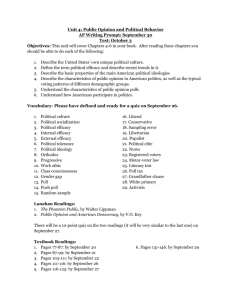
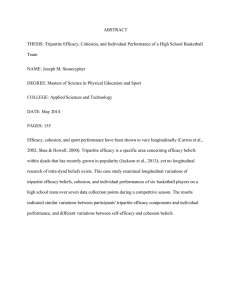
![Quality assurance in diagnostic radiology [Article in German] Hodler](http://s3.studylib.net/store/data/005827956_1-c129ff60612d01b6464fc1bb8f2734f1-300x300.png)
